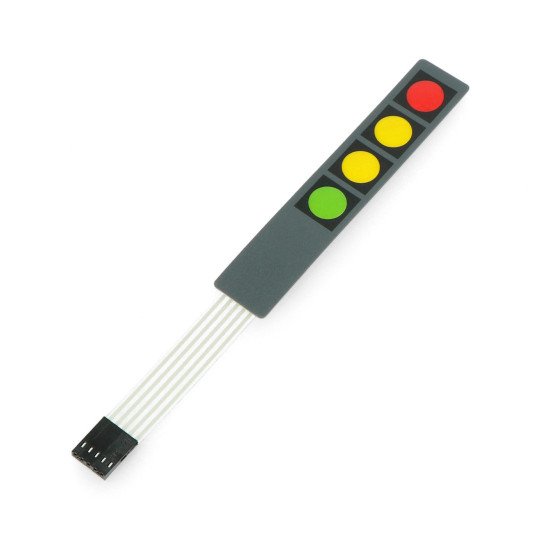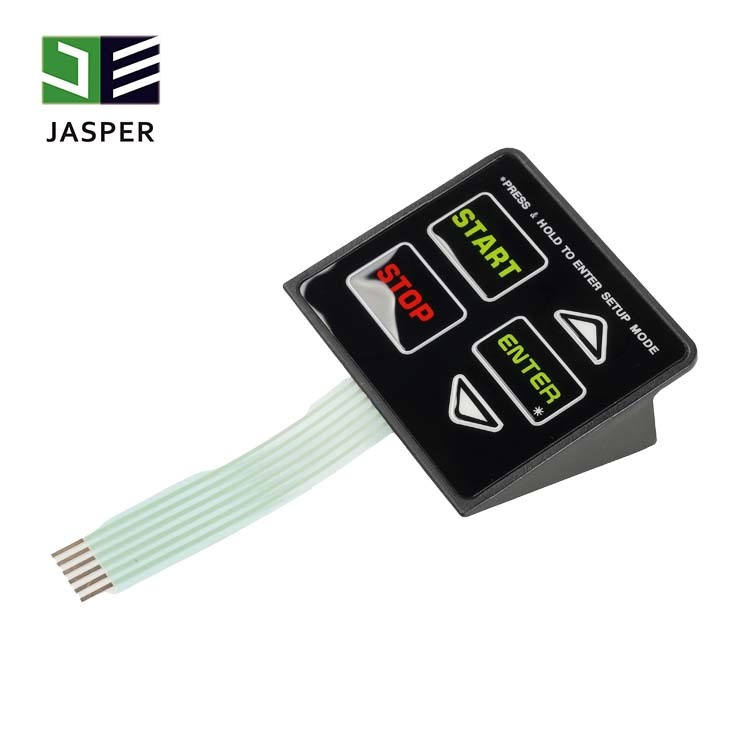Worldwide Membrane Switch Manufacturer with Flexible Production Options
Worldwide Membrane Switch Manufacturer with Flexible Production Options
Blog Article
Discovering the Production Process of Membrane Switch for Numerous Industries
The production procedure of Membrane buttons is a complicated venture that demands accuracy and interest to information. From picking ideal products to applying extensive top quality control actions, each action plays a crucial role in making certain capability. Different markets, including automotive and clinical, count on these parts for their special applications. Comprehending the details of this procedure discloses considerable insights into how these buttons are produced and their influence across diverse industries.
Comprehending Membrane Changes: A Summary

Secret Products Used in Membrane Switch Manufacturing
In Membrane switch production, the choice of crucial materials significantly affects capability and toughness. Conductive materials, adhesives, and layers play important roles, while substratum option affects overall efficiency and reliability. Recognizing these components is crucial for optimizing the layout and production of Membrane buttons.
Conductive Materials Review
Conductive materials play a crucial duty in the functionality of Membrane buttons, making sure dependable electric links within the device. Frequently made use of materials consist of silver, copper, and carbon-based inks, each offering distinctive advantages. Silver is favored for its high conductivity and resilience, making it ideal for applications needing durable efficiency. Copper, while a little much less conductive than silver, is an affordable choice often used in printed circuits. Carbon-based inks supply a functional option, appropriate for applications where versatility and lower costs are prioritized, although they have reduced conductivity contrasted to steel choices. The option of conductive materials straight affects the general integrity, life-span, and performance of the Membrane switch, making it an essential consideration in the production procedure.
Adhesives and Coatings
Coatings and adhesives are crucial parts in the manufacturing of Membrane buttons, offering crucial bonding and safety residential or commercial properties. These products guarantee that different layers of the switch, including graphic overlays and circuitry, adhere safely to one an additional, boosting durability and capability. Typically used adhesives include pressure-sensitive adhesives (PSAs) and epoxy-based formulations, which offer strong adhesion and strength. Coatings, such as polyurethane or acrylic, offer to safeguard against ecological variables, consisting of moisture, abrasion, and chemicals. Additionally, finishings can improve tactile responses and visual charm, adding to the total individual experience. The choice of ideal adhesives and layers is vital for maximizing efficiency and longevity in diverse applications across various markets, ensuring that Membrane switches over meet particular operational needs.
Substrate Choice Elements
Substrate selection plays a crucial function in the manufacturing of Membrane switches, as it considerably affects their general performance and durability. Secret products such as polyester, polycarbonate, and adaptable printed circuit boards (FPCBs) are typically used for their distinctive residential properties. Polyester is preferred for its cost-effectiveness and resistance to abrasion, making it suitable for applications with high wear. Polycarbonate offers premium clarity and effect resistance, perfect for atmospheres requiring high exposure. FPCBs give enhanced adaptability and are commonly used in complicated styles. The selection of substrate likewise influences factors like thermal stability, chemical resistance, and convenience of printing. Eventually, picking the appropriate substrate is important for making certain the performance and long life of Membrane switches over across numerous sectors.
The Design Process of Membrane Switches Over
The design process of Membrane switches is an important stage that greatly influences the performance and visual appeals of the end product - membrane switch manufacturer. It starts with specifying the details needs of the application, consisting of dimensions, switch format, and responsive comments choices. Developers have to take into consideration user interaction, making sure that the button is user-friendly and accessible.Next, materials are picked based upon durability, flexibility, and ecological resistance. The integration of graphics and branding aspects is also important, as it enhances visual allure and interaction. Prototyping enables for iterative screening, making it possible for changes based upon individual comments and performance evaluations.Additionally, the design has to make up the electric elements, such as circuits and adapters, guaranteeing reliability and ease of usage. Ultimately, an effective layout balances capability, visual appeals, and user experience, leading the way for effective manufacturing and long-lasting efficiency in different sectors
Printing Techniques for Membrane Changes
The printing methods utilized in Membrane button production play a crucial duty in establishing the final item's quality and capability. Screen printing supplies advantages such as longevity and dynamic shade application, while electronic printing innovations supply versatility and precision in style. Understanding these techniques can greatly influence the overall efficiency of Membrane buttons in different applications.
Screen Printing Benefits
Various benefits make screen publishing a preferred method for look at this now producing Membrane buttons. This approach permits premium, dynamic shades and thorough layouts, which are essential for user interface applications. Screen printing is particularly effective for applying thick ink layers, enhancing sturdiness and responsive feedback. In enhancement, it supplies superb adhesion to different substrates, making certain long life in requiring atmospheres. The procedure is cost-effective for large production runs, discover this info here as it minimizes configuration time and waste. Furthermore, display printing supports a large range of inks, consisting of specialty and UV-curable choices, enabling versatility in design. Its capacity to create constant results throughout multiple units makes it a reputable option for manufacturers going for quality and effectiveness in Membrane button manufacturing.
Digital Printing Innovations

Advancements in electronic printing innovation are transforming the manufacturing of Membrane buttons, using manufacturers cutting-edge options that enhance style adaptability and effectiveness. Digital printing enables elaborate layouts and high-resolution graphics, enabling personalized branding and performance without the constraints of conventional approaches. This method reduces configuration times and prices, helping with shorter manufacturing runs and marginal waste, making it optimal for organizations with varying demands. Furthermore, developments in ink formulas supply much better resilience and bond, making certain longevity in different settings. As industries increasingly seek personalized and complicated styles, electronic printing sticks out as an essential strategy, establishing a brand-new criterion in Membrane button production. The combination of these innovations placements suppliers to fulfill advancing market requires efficiently.
Assembly and Layering of Membrane Switch Components
Cautious setting up and layering of Membrane switch parts are vital to ensuring capability and longevity. This procedure starts with the accurate placement of different layers, including the graphic overlay, adhesive, circuit layer, and backing product. Each component should be thoroughly positioned to maintain electrical stability and individual interface responsiveness.During assembly, conductive traces are related to the circuit layer, generally made from products like polyester or polycarbonate. This layer is important, as it transfers signals when pressure is applied. The glue made use of for bonding these layers is also selected for its capability to withstand ecological anxieties while maintaining a safe and secure bond.Heat and stress are frequently used throughout the assembly process to ascertain that the layers stick properly without jeopardizing the capability of the button. Focus is provided to the edge securing to protect versus wetness and contaminants, safeguarding the durability of the Membrane switch in various commercial applications.
Quality Assurance Measures in Membrane Switch Production
Quality assurance steps play an essential function in ensuring the reliability and efficiency of Membrane changes following the setting up and layering of their elements. In the production process, numerous essential examinations are conducted to promote quality standards. These consist of aesthetic assessments for flaws in printing and adhesive application, along with functional examinations to validate the responsiveness of each switch.Additionally, environmental testing is performed to examine the switches' durability against temperature level fluctuations and humidity direct exposure. Suppliers usually apply statistical procedure control (copyright) techniques to keep track of manufacturing consistency, allowing early discovery of anomalies.Furthermore, traceability systems are developed to track materials and components, making sure liability and helping with remembers if essential. Calibration of devices and adherence to industry criteria are also important to keeping product stability. Collectively, these top quality control procedures secure the efficiency of Membrane switches throughout different applications, eventually boosting consumer contentment.
Applications of Membrane Switches Throughout Different Industries
Membrane buttons are used throughout a diverse variety of industries, showcasing their adaptability and versatility. In the medical field, they provide water-proof and reliable interfaces for devices such as analysis equipment and infusion pumps, making see post sure hygiene and ease of usage. The automobile industry employs Membrane buttons for dashboard controls, making it possible for smooth interaction in between the motorist and lorry systems.In consumer electronic devices, these buttons are found in appliances and portable gadgets, providing a smooth, modern aesthetic while improving functionality. Industrial applications additionally take advantage of Membrane switches over for machinery control panels, where durability and resistance to extreme problems are essential.Furthermore, the aerospace and protection markets use Membrane buttons for cockpit instrumentation and interaction systems, prioritizing integrity and performance under severe conditions. Overall, Membrane buttons play an important role in enhancing the customer experience and functional efficiency throughout various domain names.
Frequently Asked Concerns
How much time Does It Require To Manufacture a Membrane Layer Switch?
The manufacturing time for a membrane button typically varies from a couple of days to several weeks - membrane switch manufacturer. Variables influencing this period include design complexity, material schedule, and production volume, all affecting the total timeline substantially
What Is the Common Life-span of a Membrane Switch?
The typical life-span of a membrane switch normally varies from 1 to 5 million actuations, depending on aspects such as worldly top quality, environmental problems, and use frequency, considerably impacting sturdiness and overall performance.
Can Membrane Switches Over Be Custom-made for Specific Applications?
Membrane buttons can certainly be tailored for certain applications. Their layout flexibility enables alterations in size, shape, shades, and graphics, guaranteeing compatibility with one-of-a-kind needs throughout numerous sectors and boosting performance and customer experience.

Are Membrane Changes Eco-friendly?
The ecological impact of Membrane switches varies. Some products used may not be green, while improvements in manufacturing processes are significantly concentrating on sustainability, intending to lower waste and promote recyclable components in their production.
What Are the Usual Failure Settings of Membrane Switches?
Usual failure settings of Membrane buttons consist of delamination, adhesive failure, deterioration from use, moisture access, and electrical failures. These problems can substantially affect performance, efficiency, and life expectancy in numerous applications throughout various markets. Membrane switches can be customized to fit details layout needs, such as dimension, functionality, and form, making them highly adaptable.The construction commonly includes numerous layers, consisting of a visuals overlay, sticky, and a circuit layer, which function with each other to develop a smooth customer experience. In Membrane button production, the option of crucial products substantially influences performance and toughness. The auto sector utilizes Membrane switches for dashboard controls, enabling seamless interaction in between the driver and automobile systems.In consumer electronics, these switches are located in devices and portable tools, supplying a streamlined, modern-day visual while improving performance. Industrial applications likewise leverage Membrane changes for machinery control panels, where longevity and resistance to severe conditions are essential.Furthermore, the aerospace and defense fields make use of Membrane switches for cockpit instrumentation and communication systems, focusing on dependability and performance under extreme problems. Membrane switches can indeed be tailored for details applications.
Report this page